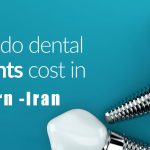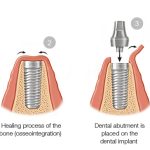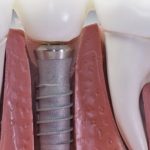Dental implant in Tehran - Iran
A dental implant is a safe and effective replacement for a tooth root. They are usually made of titanium. Since the dental implant fuses with the bone after being placed in the jaw, it creates a stable and strong base for the replacement teeth. Today, more than 40 different types of dental implants are designed for different needs of patients. Each is specifically designed for different functions. In our dental implant clinic in Tehran, we use world famous brands such as Straumann. We provide our dental services with innovation and personalized solutions for your oral health needs.
Our dental clinic, located in Tehran , Iran at Medical Building No. 241, 3rd Floor, Unit 11, Next to Sports Club, Farmanieh (Lavasani) is dedicated to providing top-notch dental care. Additionally, you can reach out to us directly at +98 21 2611 0052 or +98 21 2611 0053 to schedule appointments or inquire about our services.
Dental implant materials that we use in my tehran dentist clinic
For so many years, virtually all dental implants were derived from one material called titanium. But with the advent of technology, more and more dental implants are now made from different dental implant materials. These materials have seen extensive research, critically considering the physical and chemical properties that affect their clinical applications. Such properties include the microstructure and the surface composition of an implant. Preferably, dental implant materials should appear biocompatible. They should also be resistant to both corrosion and fracturing.
Dental implant materials can consist of titanium or zirconium material design. Notwithstanding the dental implant materials, they must be sturdy and robust. The strength of the dental implant materials and its design must remain compatible with physical property.
Below are the common types of dental implant materials used in making dental implants today.

Titanium dental implant materials
Made from metal, Titanium is regarded as the most common type of dental implant materials. Its great characteristic was discovered in 1950. During this time, findings show that implants made from titanium metal allow the bone to grow aright. That is, when placed in contact with the bone and is not disturbed; the bone will grow next to them. This will, in turn, create a permanent affinity.
From the time of this discovery, titanium dental implant materials have been the most sought-after implants. It provides long-lasting results, and the cost is very reasonable. It remains one of the best dental implant materials of all times.
Zirconia dental implant materials
In contrast to titanium, zirconia is a recent invention. It is regarded as the most promising future of dental implant materials. Zirconia dental implant materials saw full abutment uses in the early 1990s. But during this time, titanium implant materials were still in vogue.
It was not until 2003 that coralroot released the first dental implant materials-based all-in-one crown. Although they are relatively new, zirconia dental implant materials are rising in popularity.
Straumann implant in Tehran
The Straumann® Dental Implant System was designed on the basis of simplicity and freedom of choice: one system with one kit that can be used for all indications and a unique portfolio of different materials and surfaces, including groundbreaking technologies such as Roxolid® and SLActive®.
One of the prominent services offered at My Tehran dentist clinic involves the utilization of Straumann dental implants. Straumann, as a leading manufacturer in the field of dental implants, is recognized for its high-quality standards and technological advancements. The Straumann implants, with their precise design, are acknowledged for providing maximum strength and long-term durability. These implants, distinguished for their reliability and superior quality, are well-suited for a diverse range of dental restoration
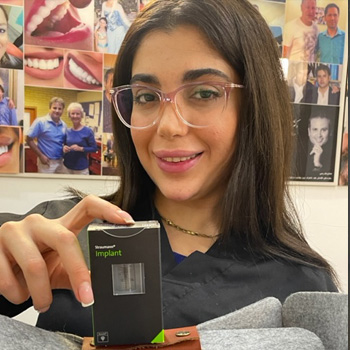

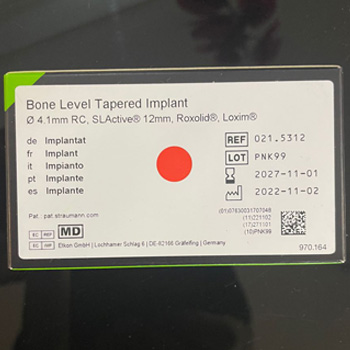
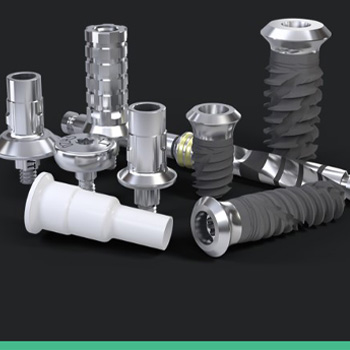
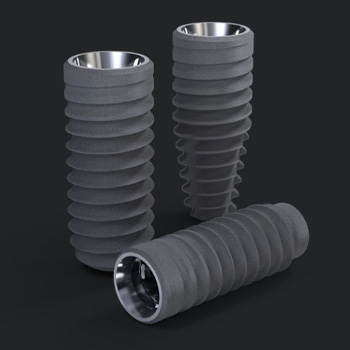
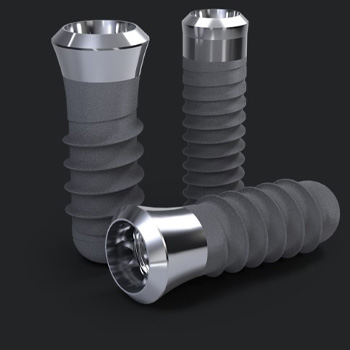
Dental implant surface
Modern implants have the bone contact surface in rugose topography to allow bone cells to settle on and osseointegrate it, and the one in contact with gums has a smooth, shiny topography, for epithelial gum cells to adhere, sealing the space surrounding the implant’s neck. Technology has enabled the creation of rugose surfaces in several topographies (nano and micro rugosity), so that bone cells can perfectly adhere to the implant. The more rugose surface and carefully processed, the higher the dental implant quality. That because bone adheres much better and more uniform, and present rugosities increase the contact surface between implant and bone, increasing its mechanical stability initially and biological subsequently to osseointegration.
Different materialsof Dental Implants
As discussed earlier, the two primary dental implant materials are titanium and zirconia. Each of these two dental implant materials has their unique features.
For instance, titanium has been tested and provided a high success rate in both medical and dental procedures. Its versatility set it apart from the zirconia. As a metal, titanium has been the first choice in all forms of bone and plate implant. Millions of patients have reaped the benefits of titanium.
Below are reasons why titanium remains better than zirconia as the most efficient dental implant materials in history.
- Titanium dental implant materials and its designs can be produced in a two piece system. These are, a separate abutment sitting atop the implant and connecting to the replacement tooth. The other is a post that is surgically implanted in the bone. The zirconia doesn’t have this capability. Instead, it is manufactured as a single piece.
- Again, titanium is the best dental implant materials because it is biocompatible. This means it is right and closely matched the human body. It can also fuse with the human bone.
- The two pieces system allows for a customizable implant that solves low bone deficiencies. This means you can still have a pleasant smile even if you are experiencing bone loss.
- However, the zirconia dental implant materials combine both post and abutment into making one unit. This reduces the fear of bacteria hiding and affecting the gum. Despite this good advantage, zirconia dental implant materials and their ceramic designs are not fully appreciated yet. This is because it has not been around for too long. So, unlike the titanium dental implant materials, it hasn’t seen any tests yet.
Types of Methods and Techniques of dental implants that we perform in Tehran
There are three common types of dental implants that you can choose from Endosteal, subperiosteal, and zygomatic.
Endosteal is the safest and most common, followed by subperiosteal, and then zygomatic being the last and most complex. It is rarely used.
Endosteal Implants
Endosteal implants are the most common type of dental implant. They are suited for most patients but, they require a good, healthy jawbone for the post to fuse to.They are placeholder posts that are shaped like screws. They put into the jaw that the false teeth are fitted onto.Once the procedure is done it takes a little time to heal. It requires the time to fuse together and create a stronghold. Once it’s healed the false teeth can be placed onto the post to fit in with the surrounding teeth.If you don’t like the idea of something being placed into your jawbone, you might like the idea of the second most common implant a little more.


Subperiosteal Implants
Another type of dental implant is Subperiosteal Implants. This is the main alternative to Endosteal Implants.
Instead of being fixed into the jawbone, subperiosteal implants rests on top of the bone but still under the gum.
A metal frame is placed under the gum with a post attached to it. The gum then heals around the frame to hold it in place. The false teeth are secured to the poles that come from the gum.
This procedure is only used if the patient doesn’t have enough jawbone for an implant to be placed or if the person in question just doesn’t want to go through with intensive oral surgery to add bone to the area. If this applies to you, maybe this next implant will suit you better.

Zygomatic Implants
Zygomatic implants are the least common type of dental implant available to you. It is the most complicated procedure and should only be done if you don’t have enough jawbone for the Endosteal implant.
Zygomatic implants are placed in the back of the maxillary bone (superior), where maxillary sinuses reside and bone has the lowest density. The tips of these implants are anchored into the zygomatic bones (cheekbones), which maintain volume and density throughout time, even if the maxillary bone is resorbed. These implants are recommended for severe maxillary atrophies, when there is practically no bone left (in the superior maxillary) or remaining bone is in an extremely low quantity, being filled with air by exaggerated sinus volume enlargement.
In this case it represents a good alternative to invasive surgery, when patient is unable or unwilling to undertake complex bone additions for lost bone volume enlargement in this region. Zygomatic implants rapidly and efficiently ensure an excellent stability in the posterior area for immediate dental works (allows immediate anchoring to fixed works).
Zygomatic implant insertion is carried out through extremely complex surgical procedures that involve an experienced medical team (implantologists, oral and maxillofacial surgeons, prosthetists, anesthetist, etc.) and all equipment specific for a major surgical act – operating block, general anesthesia, dental CT scanner, etc.
Other Techniques
If complications arise and your jaw cannot support implants and a Zygomatic implant is absolutely out of the question, your dentist may suggest other alternatives.
Bone Augmentation: Your dentist will restore the bone in your jaw if, in the case, it can not support implants. It’s possible to use bone additives to fortify the bone. that sounds like something out of Star Trek, but it can actually work.
Sinus Lift: This procedure involves adding bone below the sinus if the bone there has managed to deteriorate due to missing upper back teeth.
Ridge Expansion: It is possible that your jaw is simply not wide enough for implants. In this case, your dentist can graft material to be added to a space created along the top of your jaw.
Any three of these techniques can work to make space for implants, however, if your dentist deems these a bad idea not all is lost. There are still a few more techniques your dentist may suggest.
Different Methods of Dental Implants
There may be implant alternatives that could work well depending on the strength of your jawbone, and your specific situation. These types may be used instead of or in addition to traditional types of dental implants. Common types of dental implant methods include:
Immediate Load Dental Implants (also known as Teeth in a Day)
Immediate load implants allow you to walk out of your appointment with a full set of teeth without the delay typically required for healing. The teeth you get initially are temporary until the implant heals and you have the healthy bone contact to support a permanent prosthetic. This can be a great way to get your smile back as soon as possible.
All-on-4 (or 5 or 6)
This type is ideal for people who have lost most or all of their teeth due to decay or gum disease. It allows you to place implants without bone grafting by using a set of temporary teeth placed the same day or very soon thereafter.

Single Tooth Implants
This is great for those who have one or a few missing teeth. A single implant can fill in the gap and create a seamless look and perfectly functioning teeth

Multiple Implants
If you have several missing teeth creating larger gaps, but still don’t need a full mouth replacement, you can use multiple implants in only the areas with large gaps.

Two-Stage Dental Implants
This is the typical process for the types of dental implants described above. The first day involves a surgical procedure to place the implant into the jawbone. Several months later, a minor surgery is performed to attach an abutment and tooth (crown).
Single-Stage Implants
This is similar to two-stage implants, but the implant healing cap remains visible so the abutment and temporary restoration can be attached without the need for surgery to expose the head (top of the implant).
Mini Implants
These are small or narrow diameter implants that may be placed through less-invasive techniques to stabilize a lower denture. Mini implants can prevent the spontaneous “floating” or shifting of a lower denture. The proper position of the top of the mini implant is most important so there is space for your denture! The opportunity to get the replacement teeth right where they belong for your smile should not be lost by mini implants that are too tall or poorly positioned, nor should the denture base holding the teeth be too thin or too thick in critical places!

Dental Implant Coatings, Connectors and Sizes
More than 60 companies manufacture types of dental implants and/or the materials used to create them. As a result, dentists have many options for identifying the right treatment for specific patient needs.
Coatings
There are several different coating types or surface treatments your implants can have. While the actual implant will most likely be made of titanium, the outer surface can vary.
- Why do I want a coating? By increasing the surface roughness, the implant can heal seamlessly and become stronger than ever before. A porous surface contributes to more bone contact than a machined titanium surface.
- Types of Dental Implant Coatings Available:Possible surfaces include a grit-blasted or acid-etched and roughened surface, a microgroove or plasma-sprayed titanium surface, a plasma-sprayed hydroxyapatite coating, or Zirconia. While Zirconia is a metal, it is a transition metal. It’s typically very white and ceramic like in its appearance unlike titanium and many other colored metals.

Dental Implant Connectors
All types of dental implants require the screw or implant to be in the jaw and be attached to the abutment (or connector for the fake tooth) on top. There are three main connector types:
- Internal Hex Connectors: Shaped like a hexagon, an internal hex connector is an opening in the implant head into which the restoration/abutment is screwed.
- External Hex Connectors: Also shaped like a hexagon, these types of connectors are atop the implant head rather than inside.
- Internal Octagon Connectors: Shaped like an octagon, an internal octagon connector has an opening in the implant head into which the restoration/abutment is screwed.

